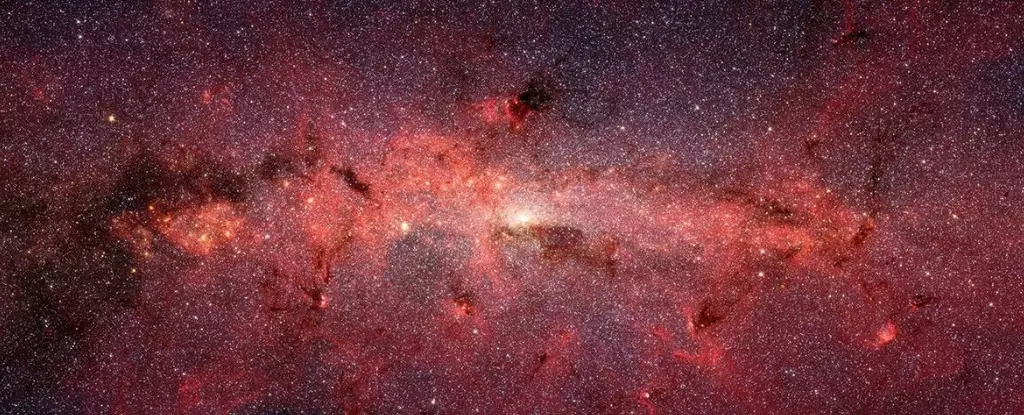The Milky Way, a sprawling cosmic tapestry, conceals elements of mystery that continue to baffle even the most astute scientists. At its heart lies the central molecular zone (CMZ), a turbulent arena where gas serves as both stage and actor. It has been discovered that gas in this area exhibits an unexpectedly high rate of ionization, a phenomenon that demands our deepest scrutiny. Simultaneously, the enigmatic glow of gamma rays emitting at 511 kilo-electronvolts (keV) beckons challengers of conventional understanding. The fundamental discrepancies surrounding these two phenomena transcend the boundaries of ordinary astronomy, questioning our grasp of fundamental cosmic dynamics.
The CMZ, sprawling across nearly 700 light-years, encapsulates some of the most densely packed molecular gas in the universe. Despite several decades of observations, the mechanisms responsible for this peculiar ionization remain obscure. While the presence of cosmic rays and starlight are often cited as contributing factors, they fall short of detailing the overly expedited ionization observed. When elements display an unexpected behavior, it’s time for scientists to dig deeper, and the quest for truth is fraught with uncertainty and wonder.
Gamma Rays: A Mysterious Emission
The gamma rays, specifically those detectable at 511 keV, originated from annihilation events involving electrons and their antimatter counterparts, positrons. First documented in the 1970s, this gamma-ray emission remains an unsolved riddle in astrophysics. Numerous hypotheses surrounding supernovas, neutron stars, black holes, and even the potential ramifications of dark matter have risen to the surface, yet none manage to cohesively explain the emission’s intensity and distribution. This persistent mystery ignites curiosity: Could there be a single process at play, one that offers clarity amidst the chaos?
In a daring intellectual pursuit, some astrophysicists have proposed that these puzzling phenomena might stem from the very essence of dark matter. This elusive substance constitutes a staggering 85% of the universe’s total content, yet its properties remain largely unobservable and shrouded in ambiguity. This contradiction presents not only an intriguing puzzle but also a pressing urgency to decipher what dark matter truly is.
The Dark Matter Connection
Emerging theories postulate that dark matter particles may possess surprisingly light masses, significantly below that of protons. These sub-GeV dark matter candidates might interact with their antiparticles, resulting in annihilation events that yield both electrons and positrons. If true, this could forge a direct link between the ionization characteristics observed in the CMZ and the perplexing gamma-ray emissions that have haunted astronomers for decades.
Unpacking the results from computer simulations reveals that when light dark matter particles undergo annihilation in the densest sections of the CMZ, they could feasibly provoke a swift release of energy. As these interactions take place, the ionization would manifest vigorously, successfully explaining the anomalously high ionization rates detected in the region. This compelling theory does not solely connect ionization to dark matter; it also proposes a mutual origin for the gamma-ray emissions, suggesting dark matter’s role in creating the positrons that eventually annihilate, emitting 511 keV gamma rays.
The Implications of Observational Evidence
As each layer of this cosmic puzzle is peeled back, a larger picture begins to take form: the potential for dark matter to shape our understanding of galactic phenomena significantly. This revelation carries massive implications for future observational strategies. The ionization rate in the CMZ becomes invaluable, acting as a guidepost in our quest to comprehend dark matter’s elusive nature. Thus, the CMZ warrants continued examination and energy, providing a robust platform from which theories can be tested against empirical data.
What’s particularly fascinating is that the ionization produced by dark matter particles is spread relatively uniformly across the CMZ, a trait ill-suited for explanations based on localized sources such as black holes or supernovas. Instead, these findings highlight the necessity of a distributed, halo-like form of dark matter that could fit harmoniously into our current models of the universe.
Charting the Path Ahead
The future of cosmic research seems ripe for exploration. Advanced telescopes poised to probe the Milky Way’s inner workings may soon glean insights regarding the relationships between ionization and gamma-ray emissions. As both astronomers and physicists seek to reconcile their understanding of dark matter and its ramifications, the universe appears ever more willing to reveal its secrets.
However, an essential contemplation lingers: Are these ephemeral signals from inside our galaxy merely precursors to larger truths, or do they signify profound cosmic interactions that might redefine humanity’s fundamental concepts of the universe? We stand at the precipice of a cosmic revolution, driven by the enigmatic phenomena that lie at the center of our very own galaxy. It compels us to continue our search for answers, illuminating the celestial dance of dark matter and its contributions towards greater cosmic understanding.

